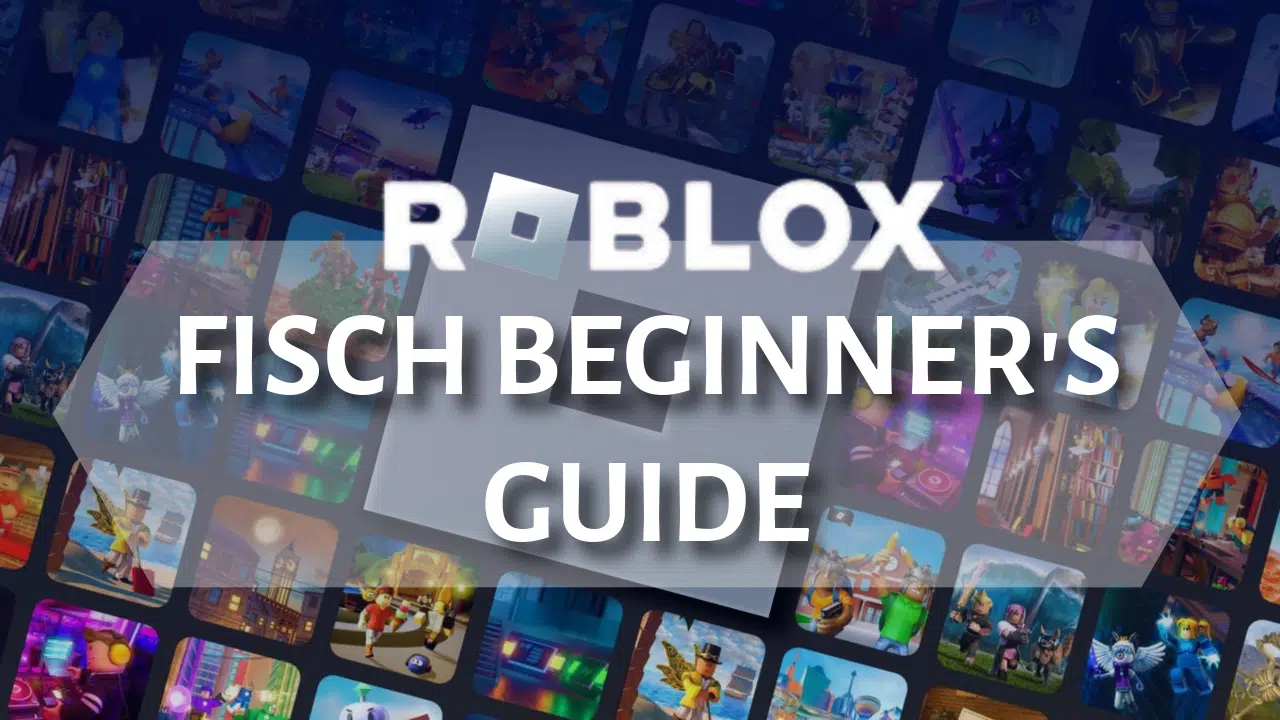
Introduction to Roblox Fisch Beginners Guide
Welcome to the ultimate Roblox Fisch Beginners Guide, your go-to resource for becoming a master angler in one of Roblox’s most immersive fishing adventures.
Roblox Fisch is an exciting and immersive fishing adventure game where players can explore vibrant islands, catch a variety of fish, and work their way up to become the ultimate angler. Whether you’re casting your line on the tranquil shores of Moosewood Island or navigating the open waters in search of rare species, Roblox Fisch offers endless opportunities for fishing enthusiasts. As you progress, you’ll upgrade your rods, discover new locations, and unlock special equipment to enhance your fishing experience. Whether you’re a casual player or aiming for mastery, this game offers fun for anglers of all levels. Grab your rod, and let’s dive into the world of Roblox Fisch!
How to Launch Into Roblox Fisch
To play Roblox Fisch, begin by installing Roblox from your device’s app store. After setting up your account, search for “Fisch” in the game menu and press play to begin your journey.
You’ll spawn on Moosewood Island, your hub for early progression. The first NPC you’ll meet is Pierre, who hangs out near the dock—usually to the left of the Shipwright. Look for glowing lines on the ground that guide you to his location. Talking to Pierre initiates your first quest, typically asking you to catch a few fish. Don’t forget to collect your daily coin rewards each time you log in; these can be a huge help for buying gear early on.
Learning to Fish: Step-by-Step Mechanics
Fishing in Fisch is easy to pick up but has enough depth to keep things interesting as you refine your skills. Whether you’re a first-time angler or looking to become a master fisherman, here’s a full breakdown of how it works from start to finish.
Equip Your Rod
To begin, you’ll need to have a fishing rod equipped. Everyone starts with the basic Flimsy Rod, which is perfectly fine for getting used to the mechanics. Whenever you’re near a body of water—whether it’s a pond, river, or coastal area—tap the rod icon to ready your gear. Your character will automatically face the water, preparing for a cast.
Casting the Line
Casting is simple but has a bit of nuance. Tap and hold anywhere on the screen to charge your cast. A power meter will appear, gradually filling as you hold down. The longer you hold, the farther your cast will go. When you’re ready, release to send your line flying. While casting farther doesn’t increase your chances of catching rare fish directly, it can help you reach spots where fish are more densely packed or less disturbed, which can indirectly improve your odds.
Activate Shake (Optional, but Strategic)
Once your bobber hits the water, you might notice a small “SHAKE” icon appear. Tapping this button will lightly jiggle the line, which can attract nearby fish and speed up how quickly one takes the bait. It’s entirely optional, but if you’re aiming to catch fish faster or are trying to trigger a bite in a quiet spot, tapping the shake prompt a few times can be very helpful. Keep an eye out—when a red exclamation mark (!) appears above your character’s head, it means you’ve got a bite.
Hooking the Fish
As soon as you see the red “!” indicator, tap the screen to hook the fish. This immediately launches you into a short reflex-based minigame. Timing matters here—a late tap can cause the fish to get away, and an early one might scare it off entirely. The visual and audio cues give you a fair window to react, so keep your attention sharp.
Reeling It In
Once the fish is hooked, the reeling minigame begins. A tension bar will appear on the screen, along with a moving fish icon and a white rectangular block. Your goal is to keep the fish icon inside that block as it moves up and down. You can tap or hold the screen to shift the block’s position and track the fish’s movements. If the fish stays within the block, the progress bar at the bottom fills up. Keep steady, and avoid letting the fish escape the block for too long—otherwise, the tension breaks, and you lose the catch.
Some fish move unpredictably or dart quickly, which makes timing and quick reactions crucial. The rarer or larger the fish, the more erratic its movements might be, so keep calm and follow its rhythm.
Canceling the Cast
If you change your mind or the conditions don’t seem right, you can always cancel the attempt. Just tap the fishing rod icon again to put it away. Your bobber will be reeled back in, and your character returns to a neutral stance, letting you move freely without penalty.
Completing Early Quests and Selling Fish
Once you’ve caught your first few fish and started getting the hang of the fishing mechanics, it’s time to move into the next phase of your adventure—completing early quests and learning how to manage your inventory through selling and upgrading gear.
Returning to Pierre
After your initial fishing session, your first stop should be back in Moosewood Village, where you’ll find Pierre, the local guide and early quest-giver. He’s an important character in the beginning of the game, helping to introduce you to the economy and progression systems. After you’ve caught a few fish, he typically tasks you with selling some of your catch and using the coins you earn to purchase a better rod.
This is your first real taste of the game’s loop: catch, sell, upgrade, and repeat. Pierre’s quests are designed to ease you into this process gradually, so don’t worry about making perfect decisions right away. That said, there are things you’ll want to start paying attention to as you go.
Visiting the Moosewood Merchant
Right in the heart of Moosewood Village, you’ll find the Merchant, your main point of contact for selling items and buying gear. The Merchant’s shop is open daily, and he offers a variety of services that become central to your progress:
Sell All Fish: This option automatically sells every fish currently in your inventory. It’s convenient but should be used with caution, especially if you’ve caught something rare or valuable that you might want to hold onto.
Sell Selected Fish: For more control, you can manually choose which fish to sell. This is the safer option when your inventory includes high-rarity catches or quest-specific species.
Buy Fishing Rods: The shop stocks rods of increasing quality. As you advance, you’ll unlock access to sturdier rods with better tension control, longer casting range, and even passive bonuses.
Purchase Bait and Gear: Bait helps attract fish more quickly or target specific types, depending on what you use. Other gear like tackle boxes, line upgrades, and rod attachments can also be found here and are worth investing in as you level up.
Protecting Rare Fish with Inventory Locks
As you begin catching a wider variety of fish, you’ll want to pay attention to rarity and value. Some fish are harder to find than others and may be needed for specific quests, trades, or crafting recipes later in the game. Accidentally selling one of these rare fish can be frustrating, especially if you don’t realize until later.
To prevent this, use the inventory lock feature. Simply select the fish you want to protect, and tap the lock icon to prevent it from being sold accidentally. Locked fish stay safe in your inventory no matter which selling option you use, even when choosing “Sell All.”
This is especially useful when you’re multitasking or clearing space quickly, since it’s easy to mis-tap and lose something important. A good habit is to immediately lock any new or unfamiliar fish until you’re sure what it’s for.
Making the Most of Early Progress
Early quests and selling aren’t just about making money—they also teach you how to pace your upgrades. Don’t rush to buy the most expensive gear right away. Instead, build up your funds gradually, experiment with different fishing locations, and get comfortable with the mechanics.
Some fish are more abundant in specific regions or during certain times of day, and some rods are better suited to those conditions. As you explore and talk to villagers, you’ll pick up more tips about where to fish and what to use. The early game is a great time to experiment without pressure.
By completing Pierre’s starter quests, getting familiar with the Merchant, and learning how to manage your inventory wisely, you’ll set yourself up for smooth progression. Before long, you’ll be reeling in rare fish, upgrading your rod like a pro, and unlocking new features that make the world of Fisch even deeper and more rewarding.
Rod Progression: Your Key to Getting Better Fish
In Fisch, upgrading your fishing rod isn’t just about getting flashier gear—it directly impacts how effective you are out on the water. Each new rod brings improved stats and mechanics that make it easier to hook, reel, and land better fish more consistently. While skill and timing still matter, having the right rod in your hands gives you a major advantage as you explore deeper waters and chase rarer species.
Here’s how early-to-mid-game rod progression typically unfolds, and what you can expect from each upgrade:
ImageRodsDescriptionFlimsy RodThis is your starter rod, the one you begin the game with. It’s simple and gets the job done, but it has the most limited stats across the board. Reeling zones are small, tension tolerance is tight, and fish will escape more easily if you’re not precise. It’s meant for learning the ropes and catching common fish near the starting area.Best for: Learning the basics
Downsides: Low resilience, slow lure speed, and no stat boosts Training RodThe Training Rod is designed to be more forgiving for new players. It features a wider reeling zone, which makes the reeling minigame much easier to manage. The fish icon stays in the sweet spot longer, and the rod absorbs a bit more tension before snapping. This helps reduce frustration early on and lets you focus on rhythm and timing.
Improved Stats:
-Slight boost to Resilience
-Easier to maintain control during tension spikes
Best for: Players still adjusting to the reeling mechanics Plastic RodThe Plastic Rod introduces moderate upgrades without being too pricey. Its main advantage is a small bump to Resilience, which reduces the chance of the line breaking during erratic fish movement. The improvements aren’t huge, but they’re noticeable if you’re fishing in slightly more active waters or going after less common fish.
Improved Stats:
-Resilience
-Lure Speed (slightly)
Best for: Players starting to move beyond common catches Steady RodOnce you’re earning a solid stream of coins (around 7,000), the Steady Rod becomes an attractive upgrade. It’s a noticeable step up from previous rods, offering balanced improvements across all relevant stats. You’ll see fish bite a bit faster, and the rod handles tension more smoothly during longer fights.
Improved Stats:
-Lure Speed: Fish bite faster after casting
-Resilience: Better tension control, reducing line breaks
-Luck: Slightly better chances at catching uncommon fish
Best for: Consistent fishing in multiple zones and handling mid-rarity catches Carbon RodSurprisingly affordable at roughly 2,000 coins, the Carbon Rod is often one of the first meaningful upgrades players go for. Despite the low cost, it offers well-rounded stat improvements and tends to be more durable than earlier options. It’s a strong choice for early-mid game players who want reliable gear without investing too much.
Improved Stats:
-Moderate increases in Resilience and Lure Speed
-Good all-around rod for steady progression
Best for: Balanced fishing across several locations without needing to micromanage stats Arctic RodThe Arctic Rod marks the jump into mid-game gear. Costing around 25,000 coins, it’s a serious investment, but one that pays off immediately. This rod offers high base stats and exceptional performance across the board. With better Luck and faster Lure Speed, it gives you a real edge when targeting rare and fast-moving fish. The increased Resilience also makes high-tension fights more manageable.
Improved Stats:
-Luck: Higher chance of rare or valuable fish
-Lure Speed: Shorter wait times after casting
-Resilience: Greater stability during intense reeling
Best for: Players ready to take on bigger challenges and pursue high-rarity fish in more competitive regions
Each rod improves stats like Luck, Lure Speed, and Resilience, which affect your fishing efficiency. You can equip new rods through your inventory.
Enhancing Your Equipment: Bait, Bobbers, and More
In Fisch, fishing starts simple, but the deeper you go—literally and figuratively—the more you’ll realize how much your equipment shapes your success. It’s not just about having a decent rod; supporting tools like bait, bobbers, and even boats begin to matter more and more as you progress. Each tool comes with its own strengths, timing, and strategy, and learning how to use them effectively adds another rewarding layer to the game.
Bait
Bait is one of the first tools you’ll be able to use to modify your fishing experience. It enhances key stats like Luck, which increases your odds of catching rarer fish, and Lure Speed, which shortens the delay between your cast and a fish biting. These two factors alone can significantly speed up your fishing sessions and improve your haul, especially once you’re aiming for uncommon or elusive fish.
However, not all bait is without drawbacks. Some types provide stat boosts at the cost of Resilience, meaning your rod becomes less stable during the reeling minigame—fish may shake loose more easily if you’re not careful. This tradeoff makes choosing bait a strategic decision. For example, if you’re confident in your timing and reeling control, you might risk the lower Resilience for a shot at rarer fish.
You can buy bait from a local vendor near Moosewood Village’s shoreline, and early prices tend to hover around 120 coins per unit. The selection starts simple with Worms, moves into more balanced choices like Flakes, and eventually expands to more potent types like Krill, which offer bigger stat increases and are better suited for mid- to late-game fishing. But remember—bait is consumed whether you catch the fish or not. If the fish escapes, you still lose the bait. It’s always worth keeping a small stash but be mindful of how quickly it can run out during longer sessions.
Bobbers
While often overlooked by beginners, bobbers are a subtle but powerful part of fishing customization. They don’t just sit there for visual effect—they can affect your catch rate, how deep your line sinks, and even your odds of maintaining control during a tricky reel. Some bobbers are tuned for shallow waters, while others are better for deeper, harder-to-reach fish zones.
Interestingly, bobbers in Fisch aren’t usually bought outright. Most are unlocked by progressing through the Bestiary—a logbook that tracks all the fish species you’ve caught. As you complete more entries and explore different habitats, new bobbers become available. Each one tends to offer a passive bonus or slight advantage that stacks nicely with your bait and rod upgrades. The effects might not feel dramatic at first, but they do add up, especially once you’re targeting specific fish.
Lanterns
Lanterns are available relatively early, and while they may look cool—especially at night or in dark regions—they’re largely cosmetic during the early stages of the game. They don’t increase catch rates, lure speed, or any core fishing stat. They do, however, add style to your character or rod setup and may have more meaningful use later in the game when you’re fishing in biomes where visibility is reduced. Still, early on, it’s better to hold off and prioritize gear that directly impacts your fishing performance.
Totems
Totems serve a completely different function. They’re powerful, often rare-use items designed to summon specific fish encounters, usually of a rare or boss-tier variety. One well-known example is the Megalodon, which can only be summoned through a totem under specific conditions. These are not casual-use tools—they require preparation, resources, and strong gear to take advantage of. For new players, it’s better to focus on fishing progression first. Once you’ve upgraded your rod and unlocked better bait and bobbers, you’ll be in a much stronger position to take on the types of challenges that totems introduce.
Crab Cages
Crab cages bring a passive dimension to fishing. Instead of catching fish directly, these let you collect seabed creatures like crabs and shellfish, which are often needed for quests or crafting. The process is straightforward: purchase a crab cage, place it in a valid water zone—usually along a shoreline or in shallow tidal areas—and return later to retrieve your haul.
Each crab cage is single-use, meaning after you collect the contents, the cage is consumed. They’re a great way to multitask while exploring or completing quests in the area, and they can be surprisingly rewarding if used in the right locations.
GPS and Radar
As you start receiving quests that involve precise travel or exploration, the GPS becomes one of your most practical tools. It’s relatively cheap, usually around 100 coins, and allows you to track your exact coordinates. This is especially useful when looking for specific fishing spots or rare fish that only appear in certain areas.
The Radar, on the other hand, is a high-end upgrade—priced around 8,000 coins—and provides a real-time scan of nearby fish. It tells you which species are in range and their rarity levels, allowing you to make strategic decisions before you even cast your line. While expensive, it’s a valuable tool once you’re actively hunting for specific entries in your Bestiary or trying to maximize profits with rare fish.
Boats and Exploration
Boats are where the game really begins to open up. The first one, a Rowboat, becomes available at Level 5 and can be acquired from the Shipwright, usually found near Pierre in Moosewood. Once you have a boat, entire new regions become accessible—some with rare fish, others with unique materials or quest items.
Piloting a boat uses the same joystick as walking, and movement across the water is smooth and easy to learn. As you level up, new boats become available with more features, such as higher speed, better storage, or built-in utility options. Boats aren’t just a convenience—they’re a necessity for uncovering everything the world of Fisch has to offer.
Diving Gear
Diving is another major layer of exploration. Some fish, treasures, and crafting materials are found only underwater, and to reach them, you’ll need to equip the appropriate gear. You’ll start with Basic Diving Gear, which allows you to explore shallow underwater zones. Eventually, you’ll unlock Advanced Diving Gear, which gives you more oxygen and the ability to explore deeper and more complex dive sites.
It’s important to manually equip your diving gear before entering a submerged zone—otherwise, your character won’t be able to interact with anything underwater. Diving areas are often marked by bubbles or subtle shimmer effects on the water’s surface, and exploring them can lead to secret catches or progress toward specific quests.
Mastering the Mechanics: Bestiary, Rarity, and Stats
As you progress through Fisch, the world opens up in layers. Beneath the surface-level charm of catching fish lies a set of interconnected mechanics that shape how you earn, grow, and unlock the deeper content the game has to offer. Understanding your Bestiary, how rarity tiers affect your rewards, and how stats interact with your gear will not only help you fish smarter—it will help you fish better.
The Bestiary: Your Fishing Logbook
The Bestiary is your running collection of all the fish species you’ve caught, organized by region. It acts as both a tracker and a reward system. Each fish you catch fills in an entry with details like size, location, and rarity, and completing entries in a given region—such as Vertigo, The Depths, or Moosewood Shores—can unlock special gear bonuses, unique bobbers, and progress toward long-term goals.
The Bestiary isn’t just for completionists, either. It’s tied directly to gameplay progression, and certain unlocks only become available once you’ve logged a required number of species. It’s a great way to track which regions still hold surprises, and it gives you something to work toward when you’re in between quests or exploring by boat.
Fish Rarity: From Common to Relic
Not all fish are created equal. Every species in Fisch falls into a specific rarity tier, which affects both how difficult the fish is to catch and how valuable it is when sold. The tiers—ranging from the humble Common to the ultra-rare Relic—provide a natural path of progression and reward.
At the base level, Common, Uncommon, and Unusual fish are the backbone of early-game fishing. These are the species you’ll see most often, especially when using low-tier rods and no bait. As your gear and skills improve, you’ll start seeing Rare and Legendary fish appear more frequently, particularly in remote or difficult-to-reach waters.
Even rarer are Mythical and Event tier fish, which may only spawn under specific weather conditions or during time-limited windows. At the very top sit Relic fish—the rarest tier available. These are the true trophies of Fisch, often required for special quests, enchantments, or summoning legendary creatures. Catching one is never easy, but the rewards are often well worth the effort.
In general, the higher the rarity, the more C$ coins the fish is worth. Some also offer experience bonuses, making them a good target if you’re trying to level up quickly.
C$ Coins: The Fishing Economy
Your main in-game currency is C$, earned primarily by selling fish at merchants or fulfilling quest bounties. It’s used for nearly everything—from buying rods, bait, and gear, to unlocking boats, upgrading equipment, and purchasing helpful tools like Radar or Diving Gear.
You’ll find that coin management becomes increasingly important as you progress. Early on, you’ll want to focus on building a steady income, but eventually, you’ll need to make decisions about where to spend and where to save. High-end gear can be expensive, and rare items sometimes appear unexpectedly, so keeping a coin cushion is always a smart move.
XP and Leveling Up
Every fish you catch grants you XP, and completing quests gives additional boosts. As your level increases, you’ll unlock new features, gear, and locations. For example, reaching Level 5 unlocks your first boat, which then gives you access to new islands and biomes with rarer species and better loot.
Leveling up also occasionally grants passive bonuses to your base stats or new crafting recipes, depending on your playstyle. If you’re an avid fisher, this means faster access to high-tier rods and deeper regions like The Depths or Vertigo.
Fishing Stats: How They Work Together
Every rod in the game—along with some bait, bobbers, and enchantments—affects a set of fishing stats. These are critical to understanding how your fishing experience evolves.
- Luck improves your chances of attracting rare or high-tier fish.
- Lure Speed determines how fast fish bite after your cast.
- Resilience helps stabilize the tension bar during the reeling minigame, making it easier to keep control when fish fight back.
- Control affects the smoothness and responsiveness of the white block you use during reeling. Higher Control means tighter, more accurate movement, especially useful for slippery or aggressive fish.
These stats grow in importance the further you go. A rod with high Luck and Control might be ideal for catching Mythical-tier fish in tricky regions, while high Resilience can help prevent frequent line breaks during longer battles.
Enchantments: Power From the Depths
Later in the game, you’ll unlock rod enchantments, which are special passive abilities applied to your gear. These are accessed at the Statue of Sovereignty, a mysterious location that becomes available at night in certain regions. To use it, you’ll need Relics—rare currency usually tied to special catches or event rewards.
Enchantments can dramatically enhance your fishing efficiency. For example, the Hasty enchantment reduces the time it takes for fish to bite, letting you fish faster. Lucky increases your odds of finding rare fish, while Clever gives an XP bonus per catch, helping you level up faster over time.
Each enchantment is limited to one per rod, and switching them out costs additional Relics. Choosing the right one for your build can significantly impact how you approach different regions or fishing goals.
Understanding how all these systems fit together is a big part of what makes Fisch so engaging. It’s not just about casting a line—it’s about knowing what you’re casting for, how to gear up for it, and when to push for something rare versus when to cash in on volume. Whether you’re filling out your Bestiary one entry at a time or chasing Relic-tier trophies deep in the unknown, mastering the mechanics gives you the tools to fish smarter, not just harder.
Unlocking Secret Areas: Vertigo, The Depths, and Atlantis
The world beneath the waves hides more than just fish—it conceals ancient gateways, forgotten civilizations, and some of the most powerful tools an angler can wield. To reach these hidden zones—Vertigo, The Depths, and Atlantis—you’ll need patience, skill, and a deep knowledge of the sea’s secrets. Each area has its own unique requirements, mysteries, and rewards, making the journey into these realms as rewarding as the destinations themselves.
Vertigo
Vertigo isn’t just another fishing spot—it’s an otherworldly dimension, teeming with surreal aquatic life and intense currents that twist the senses. To gain access, you must seek out Strange Whirlpools, which are marked by vertical beams of shimmering light piercing through the surface. These whirlpools appear sporadically across the open ocean, usually in areas with fluctuating weather or high concentrations of rare fish.
Entering one transports you to Vertigo, but exploration here is not straightforward. To unlock its deeper secrets and extend your time within, you must complete the Vertigo Bestiary. This means catching every unique species that dwells in this biome—some of which only appear under specific moon phases or during oceanic disturbances. Completing the bestiary doesn’t just serve as a checklist; it also triggers ancient mechanisms that grant you access to previously sealed caverns and relic chambers within Vertigo itself.
The Depths
The Depths represent the next tier of aquatic exploration, a dark and silent abyss where bioluminescent creatures drift through ruins untouched by time. Accessing this eerie underworld requires the Depths Key, which is earned only after fully completing Vertigo’s fish list. This serves as proof that you’ve mastered the challenges of Vertigo and are ready for the dangers below.
Once you descend into The Depths, the environment shifts dramatically. Visibility is limited, pressure is immense, and many creatures here are not only rare but also aggressive. However, the rewards are substantial. Chief among them is the Rod of the Depths—an exceptionally powerful fishing rod with enhanced durability, faster reeling speed, and the ability to withstand the stress of catching legendary abyssal fish. This rod becomes indispensable for both casual players seeking efficiency and completionist hunting for every hidden species in the game.
Atlantis
The most mysterious and awe-inspiring area, Atlantis, lies at the intersection of myth and reality. Unlocking it is no simple feat—it requires a multi-step journey that tests your observation skills, persistence, and ability to decode the game’s hidden lore.
Here’s how to gain access:
- Travel to the Forsaken Shores – This desolate stretch of coastline is your starting point. Scour the ruins and cliff faces carefully; environmental clues here hint at the path ahead.
- Find and pull five hidden levers – These levers are concealed across various zones, often integrated into rock formations, overgrown with kelp, or buried in shipwrecks. Each one activates a segment of an ancient mechanism.
- Obtain the Heart of Zeus – This mystical artifact is hidden within a forgotten shrine, guarded by a puzzle that requires aligning constellations reflected on the water’s surface. Retrieving it is key to powering the gateway to Atlantis.
- Enter the secret passage in the Grand Reef – Once the Heart of Zeus is in your possession, head to the Grand Reef. A coral archway near the trench will react to the artifact, revealing an entrance previously obscured by illusion and deep-sea currents.
Upon entry, you’ll find yourself in Atlantis, a sprawling, submerged city of gold and glass, where ancient tech and natural beauty merge. The fish here are entirely unique, and some of them seem almost sentient. But the highlight is the Champion’s Rod, a high-tier tool forged using Atlantean alloys. It features unmatched casting precision, elemental bait compatibility, and can handle the elusive Champion-class fish—species so rare and powerful that they’re practically legend.
Little Boost from Codes
One of the easiest ways to kickstart your journey is by redeeming in-game codes. These often reward you with free currency or helpful items that can give you an early edge. With just a few redemptions, you could afford a better fishing rod, a bigger bag, or even your first boat—tools that will make your time in the game much more efficient and enjoyable. Codes are typically released during game updates, events, or holidays, so it’s a good idea to keep an eye out for them regularly.
Use those codes to your advantage, explore the waters, and enjoy the journey. With this reblox fisch beginners guide, you’re already well on your way to becoming a top-tier angler.
Common Beginner Mistakes to Avoid
Starting your fishing journey can be exciting, but it’s also easy to fall into a few traps that can slow your progress or drain your coins unnecessarily. Here’s a breakdown of the most common rookie mistakes—and how to avoid them—so you can focus on leveling up, catching rarer fish, and making the most of your time on the water.
Wasting Coins on Weak Rods
At the start of the game, it’s tempting to spend your hard-earned coins on upgrading your rod. However, many early rod upgrades offer marginal improvements and are often outgrown quickly. Investing in rods that don’t make a significant difference to your gameplay can hinder your progress.
Instead, it’s smarter to save up for meaningful upgrades that provide a substantial boost. Rods like the Carbon Rod or the Arctic Rod tend to be much more useful, as they offer better durability, casting power, and improved fishing efficiency. These upgrades will allow you to reach new zones, catch more challenging fish, and improve your overall fishing experience.
Buying Totems Too Early
Totems are powerful items that help improve your fishing outcomes, especially with specific rare or legendary fish. However, totems are usually better suited for later in the game. Early on, you won’t be encountering the types of fish that benefit from totems, nor will you have the upgraded gear or techniques to make full use of them.
Instead of buying totems, focus on improving your rods, bait, and other essential gear. Save the totems for when you’re facing high-level challenges and when you’re better prepared to maximize their potential. This will ensure that your coins are spent more wisely during the early stages of the game.
Spending on Lanterns
Lanterns might look cool and make your boat glow like a deep-sea disco, but here’s the truth: they’re purely cosmetic during the early game. They don’t help you catch fish faster, attract rarer species, or give any practical gameplay advantage early on.
While some late-game lanterns may tie into certain biomes or hidden secrets, most serve purely as a visual upgrade. If you’re just starting out, your money is better spent on rods, bait storage, sonar upgrades, and fast travel options. Leave the fashion statements for when your gear is fully optimized.
Skipping Progression Guides
One of the most overlooked aspects of progressing in a fishing game is understanding the gear and regions that are best suited for your current level. Some rods and areas offer significant advantages over others, especially when it comes to catching rarer or higher-value fish.
It’s easy to rush through the game and skip important guides or in-game tips, but taking the time to understand which rods are best for which situations and what biomes provide the best fish is crucial for making the most of your time and coins. By following progression guides, you can unlock more powerful gear, tackle the toughest challenges, and catch those elusive, high-reward species.
Final Thoughts: The Adventure Is Just Beginning
This detailed Roblox Fisch Beginners Guide equips you with everything you need to start strong, progress efficiently, and explore the expansive waters of Fisch. From mastering fishing mechanics and upgrading rods to unlocking legendary locations like The Depths and Atlantis, there’s always something exciting to reel in.
So cast your line, stay curious, and happy fishing!













